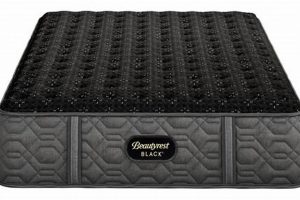The primary concern addressed is methods for increasing the rigidity of a sleep surface. This involves altering the existing characteristics of a mattress to provide enhanced support and reduce sinkage. For example, placing a firm board between the mattress and the bed frame is a common method to achieve greater firmness.
Achieving a more rigid sleep surface can offer several benefits, including improved spinal alignment, reduced back pain, and enhanced overall sleep quality. Historically, individuals have sought firmer mattresses for therapeutic reasons, believing that a stable surface promotes healthier posture and reduces pressure points.
The subsequent sections will explore several techniques for modifying a mattress’s firmness, ranging from simple adjustments to more involved interventions. This includes examining the efficacy of mattress toppers, the impact of supportive foundations, and professional mattress modification services.
Methods for Increasing Mattress Firmness
The following recommendations offer actionable steps to enhance the support and rigidity of a mattress.
Tip 1: Employ a Mattress Topper. A firm mattress topper, constructed from materials such as high-density foam or latex, can provide an additional layer of support and minimize sinkage.
Tip 2: Utilize a Supportive Foundation. Ensure the bed frame or foundation provides adequate support. Sagging or uneven support can exacerbate the feeling of a soft mattress. Consider a platform bed or a box spring designed for firmer support.
Tip 3: Insert a Mattress Board. Placing a solid board, such as plywood, between the mattress and the foundation creates a more rigid base. The board should be appropriately sized to fit the entire surface area of the mattress.
Tip 4: Rotate the Mattress Regularly. Consistent rotation helps distribute wear evenly, preventing localized sagging and maintaining a more uniform surface firmness. Rotate the mattress every three to six months.
Tip 5: Consider Professional Modification. Mattress retailers or repair services may offer options to alter the internal components of the mattress, such as replacing the comfort layers with firmer materials. This is a more involved process, but it can yield significant results.
Tip 6: Adjust Room Temperature. Memory foam mattresses, in particular, can soften in warmer environments. Maintaining a cooler room temperature may help retain some firmness.
Tip 7: Check for Warranty Options. If the mattress is relatively new, review the warranty. Some manufacturers may offer replacements or repairs if the mattress does not meet the specified firmness level.
Implementing these strategies can substantially improve the firmness and support characteristics of a mattress, leading to enhanced sleep quality and potential relief from back discomfort.
The subsequent section will provide guidance on selecting the most appropriate method based on individual needs and mattress type.
1. Support Layer
The support layer constitutes a critical element in determining mattress firmness. Its primary function is to provide the foundational structure upon which the comfort layers rest. Insufficient support results in excessive sinkage, contributing to a sensation of softness, regardless of the properties of the upper layers. Conversely, a robust support layer minimizes compression, thereby enhancing the overall firmness of the mattress. For example, a mattress with a high-density foam core will generally offer greater support compared to one utilizing a less dense material, directly affecting the perceived firmness.
The composition and construction of the support layer vary widely across different mattress types. Innerspring mattresses rely on the gauge and coil configuration of the springs to provide support. Hybrid mattresses often incorporate a combination of innerspring and foam layers, with the support layer typically consisting of pocketed coils or a dense foam base. Foam mattresses, in turn, derive their support from layers of high-density polyurethane or latex foam. Addressing deficiencies in the support layer often necessitates replacing the entire mattress or supplementing it with a firm topper to compensate for the lack of inherent rigidity.
Understanding the role of the support layer is essential when selecting strategies to increase mattress firmness. While adding a firm topper can provide a temporary solution, addressing the underlying lack of support is often a more effective long-term approach. Neglecting the support layer can lead to premature mattress wear and tear, as well as compromise the user’s sleep posture and overall comfort. Therefore, the integrity of the support layer is paramount in achieving and maintaining a firm and supportive sleep surface.
2. Base Rigidity
Base rigidity exerts a direct and substantial influence on the perceived firmness of a mattress. Insufficient support from the bed frame or foundation permits excessive mattress deflection, effectively negating the intended firmness characteristics. This compromises the overall support offered to the sleeper, potentially leading to discomfort and suboptimal spinal alignment. The lack of a rigid base acts as a confounding factor, diminishing the effectiveness of even the firmest mattresses.
Consider, for example, a high-density foam mattress placed upon a flexible slatted bed frame. The spaces between the slats allow the mattress to sag, creating localized depressions and diminishing the support provided to the sleeper’s torso. In this scenario, the inherent firmness of the mattress is undermined by the inadequate base. Similarly, a worn or damaged box spring can exhibit uneven support, further contributing to a compromised sleep surface. Ensuring a solid, non-yielding foundation is therefore a prerequisite for maximizing mattress firmness and realizing its intended benefits.
Ultimately, understanding the critical relationship between base rigidity and overall mattress firmness allows for a more targeted approach to achieving desired sleep surface characteristics. Addressing deficiencies in the foundation may be a necessary first step before implementing other firmness-enhancing strategies, such as adding a topper or modifying the mattress itself. Neglecting the base rigidity can result in a persistent sensation of inadequate support, even with a high-quality mattress designed for enhanced firmness, demonstrating the practical significance of a holistic approach.
3. Topper Selection
Topper selection is intrinsically linked to the objective of enhancing mattress firmness. The com
position and density of a mattress topper directly influence the surface feel and support provided, thereby affecting the overall rigidity perceived by the sleeper. Selecting a topper constructed from high-density materials, such as latex or firm memory foam, can augment the support and minimize sinkage, resulting in a firmer sleep surface. Conversely, a soft or plush topper would counteract efforts to increase firmness, potentially exacerbating existing issues related to lack of support. For example, an individual seeking to mitigate back pain stemming from a sagging mattress might select a firm latex topper to provide targeted spinal alignment and reduce pressure points.
Considerations beyond material composition include topper thickness and construction. A thicker topper generally offers greater potential for altering mattress firmness, as it provides a more substantial layer of support. Furthermore, the construction method, such as convoluted or zoned designs, can further refine the topper’s impact on firmness and pressure distribution. A zoned topper, for instance, might incorporate firmer sections in the lumbar region to provide enhanced support to the lower back. The effectiveness of any topper is also contingent upon the underlying condition of the mattress. A significantly degraded mattress may not respond adequately to a topper, necessitating more comprehensive solutions.
The strategic selection of a mattress topper presents a viable and often cost-effective approach to modifying mattress firmness. However, understanding the interplay between material properties, thickness, construction, and the existing mattress condition is crucial for achieving the desired outcome. While a topper can effectively enhance firmness in many scenarios, it serves as a supplementary measure and not a replacement for a fundamentally supportive mattress. Successful topper selection necessitates a careful assessment of individual needs and a thorough understanding of the available options, aligning the choice with the specific goal of achieving a firmer and more supportive sleep surface.
4. Even Distribution
Even weight distribution across a mattress surface is a crucial factor in maintaining and optimizing its firmness. Uneven distribution contributes to localized compression and premature wear, undermining the intended support characteristics and reducing the overall effectiveness of efforts to enhance firmness. Addressing this issue is integral to achieving a consistent and supportive sleep surface.
- Body Weight Dispersal
Concentrated weight in specific areas leads to accelerated degradation of those regions, creating soft spots. Regularly rotating or flipping the mattress (if applicable) promotes more uniform wear, preventing localized sagging and preserving firmness. This is particularly relevant for mattresses with zoned support, as imbalances can negate the intended benefits.
- Sleeping Position Influence
Individuals favoring specific sleeping positions (e.g., side sleepers placing more pressure on shoulders and hips) can exacerbate uneven wear. Strategies to mitigate this include using supplemental support structures, such as body pillows, to distribute weight more evenly or selecting mattresses with reinforced edge support to prevent edge collapse and maintain consistent firmness across the entire surface.
- Foundation Support Uniformity
An uneven or sagging foundation compromises weight distribution across the mattress. A foundation with weak or damaged areas will allow the mattress to deform unevenly, creating areas of increased pressure and accelerated wear. Ensuring the foundation is structurally sound and provides consistent support is essential for maintaining uniform firmness.
- Material Compression Variability
Different mattress materials exhibit varying degrees of compression under load. Hybrid mattresses, for example, may have regions with higher coil counts or denser foam designed to provide enhanced support. Uneven weight distribution can lead to disproportionate compression in these areas, altering the intended firmness profile. Regularly assessing the mattress for localized compression and addressing underlying support deficiencies is necessary to maintain a consistent feel.
Achieving and maintaining even weight distribution is paramount for realizing the full potential of strategies aimed at enhancing mattress firmness. Ignoring this aspect can lead to compromised support, accelerated wear, and a diminished lifespan of the mattress, underscoring the importance of a holistic approach that considers both surface and structural factors in the pursuit of a firmer sleep surface.
5. Temperature Control
Temperature control plays a significant, though often overlooked, role in determining the perceived firmness of a mattress. The properties of many mattress materials, particularly viscoelastic foams, are sensitive to temperature fluctuations, impacting the overall support and rigidity of the sleep surface. Maintaining consistent temperature conditions can therefore contribute to achieving a more predictably firm mattress.
- Viscoelastic Foam Sensitivity
Viscoelastic foam, commonly known as memory foam, exhibits a distinct temperature-dependent behavior. At higher temperatures, the foam softens, conforming more readily to body contours and reducing its overall firmness. Conversely, cooler temperatures cause the foam to stiffen, providing increased resistance and a firmer feel. The magnitude of this effect varies depending on the foam’s density and composition, but it remains a consistent characteristic. For example, a memory foam mattress may feel significantly softer in a humid summer climate compared to a cool winter setting.
- Ambient Temperature Influence
The ambient temperature of the bedroom directly affects the mattress’s temperature and, consequently, its firmness. A poorly insulated room that experiences significant temperature swings will result in a mattress that fluctuates in firmness throughout the day and night. Maintaining a stable and controlled room temperature, typically through the use of air conditioning or heating, can minimize these fluctuations and contribute to a more consistent sleep surface. Furthermore, the use of bedding materials that promote airflow can help regulate mattress temperature.
- Body Heat Contribution
Body heat also influences the temperature of the mattress, particularly in areas where the body makes direct contact. This localized warming can soften the foam in those regions, leading to pressure points and reduced support. Mattresses designed with cooling technologies, such as gel-infused foam or breathable covers, aim to mitigate this effect by dissipating heat and maintaining a more uniform temperature across the sleep surface. However, the effectiveness of these technologies is contingent upon the ambient temperature and individual body heat production.
- Ventilation and Airflow
Adequate ventilation beneath and around the mattress is crucial for dissipating heat and preventing moisture buildup. A poorly ventilated mattress can trap heat and moisture, creating an environment conducive to microbial growth and premature degradation of the foam. Furthermore, the increased temperature can soften the foam, reducing its firmness. Using a
breathable bed frame and avoiding placing the mattress directly on the floor promotes airflow and helps regulate temperature.
In summary, temperature control represents a subtle yet significant factor in optimizing mattress firmness. By understanding the temperature-dependent behavior of mattress materials and implementing strategies to maintain consistent temperature conditions, individuals can enhance the predictability and support characteristics of their sleep surface. While temperature control alone may not fully address issues related to inadequate firmness, it constitutes an important element in a comprehensive approach to achieving a more comfortable and supportive sleep environment.
6. Material Density
Material density is fundamentally linked to mattress firmness. Higher density materials, when incorporated into mattress construction, contribute directly to increased resistance to compression. This inherent resistance translates to a firmer sleeping surface. Conversely, lower density materials compress more readily under load, resulting in a softer feel. The selection of materials with appropriate density is therefore a critical determinant in establishing the desired firmness characteristics of a mattress.
For example, consider two mattresses constructed using polyurethane foam. The mattress incorporating high-density polyurethane foam, characterized by a greater mass per unit volume, will exhibit significantly less sinkage under an applied load compared to the mattress employing low-density foam. This difference in compression behavior directly impacts the perceived firmness, with the high-density mattress providing a more supportive and rigid surface. Similarly, within innerspring mattresses, the gauge (thickness) of the steel coils corresponds to density; higher gauge coils offer greater resistance and contribute to increased firmness. The practical significance of this understanding lies in informing material selection during mattress design and construction, as well as guiding consumers in choosing mattresses aligned with their preferred firmness levels.
In conclusion, material density is a key physical property governing mattress firmness. Understanding the correlation between density and compression resistance allows for the targeted selection of materials to achieve specific firmness goals. Addressing the material density of the mattress, either through the selection of a new mattress or the addition of a high-density topper, is a practical means of enhancing mattress firmness. Failure to consider material density can result in a sleep surface that does not provide adequate support, emphasizing the importance of this parameter in the pursuit of a firmer and more comfortable mattress.
7. Professional Assistance
Engaging professional services represents a comprehensive approach to achieving a firmer mattress when conventional methods prove insufficient. The expertise offered by mattress retailers, repair specialists, or custom bedding manufacturers addresses complex firmness issues that may stem from internal structural deficiencies or specific user requirements. Professional assistance can range from diagnostic assessments of mattress construction to custom modifications tailored to individual needs.
Examples of professional intervention include: reinforcement of existing support systems, replacement of comfort layers with firmer materials, and custom design and fabrication of mattress components to meet unique firmness specifications. Certain retailers offer in-store consultations to assess sleep preferences and provide guidance on selecting mattresses or mattress modifications suited to specific firmness needs. Some manufacturers also provide custom mattress building services, allowing for precise control over material selection and construction to achieve the desired level of support. The practical significance of professional assistance is the ability to address firmness challenges that fall outside the scope of DIY solutions, providing a personalized approach to achieving optimal sleep comfort and support.
In summary, professional assistance offers specialized expertise and customized solutions for increasing mattress firmness. While potentially involving higher costs compared to DIY alternatives, professional interventions provide a valuable resource for addressing complex firmness challenges and ensuring a sleep surface that meets specific individual needs and preferences. The reliance on experienced professionals ensures both the safety and effectiveness of mattress modifications, making it a viable option when other methods are inadequate or unsuitable.
Frequently Asked Questions
This section addresses common inquiries regarding the alteration of mattress firmness, offering detailed explanations and practical advice for individuals seeking a more supportive sleep surface.
Question 1: What are the primary factors contributing to a soft mattress?
Several factors can diminish a mattress’s firmness, including age-related material degradation, inadequate support from the bed frame, prolonged uneven weight distribution, and temperature-induced softening of viscoelastic foams. A thorough assessment of these factors is crucial for determining the most appropriate course of action.
Question 2: Is adding a firm mattress topper a universally effective solution?
While a firm mattress topper can enhance surface firmness, its effectiveness depends on the underlying condition of the mattress. A significantly degraded mattress with compromised support layers may not benefit substantially from a topper. In such cases, addressing the core support structure is a more appropriate strategy.
Question 3: How frequently should a mattress be rotated to maintain optimal firmness?
A mattress should ideally be rotated every three to six months. This practice distributes wear evenly across the sleep surface, preventing localized sagging and maintaining a more uniform level of firmness. Mattresses with specific construction or material characteristics may require more frequent rotation.
Question 4: Can adjusting room temperature genuinely impact mattress firmness?
Yes, particularly for mattresses incorporating viscoelastic foams. Cooler temperatures generally increase foam firmness, while warmer temperatures soften the material. Maintaining a stable and controlled room temperature can contribute to a more consistent sleep surface.
Question 5: When is professional mattress modification the most appropriate course of action?
Professional intervention is warranted when DIY methods fail to address underlying structural issues or when specific firmness requirements necessitate customized solutions. Mattress retailers or repair specialists possess the expertise to assess complex problems and implement targeted modifications.
Question 6: What are the long-term consequences of sleeping on a mattress that is too soft?
Prolonged use of a mattress lacking adequate support can lead to spinal misalignment, back pain, muscle stiffness, and disrupted sleep patterns. Addressing the firmness issue is therefore crucial for promoting proper spinal health and overall well-being.
These FAQs provide a comprehensive overview of key considerations related to enhancing ma
ttress firmness. Implementing the recommended strategies, or seeking professional assistance when necessary, can significantly improve sleep quality and overall comfort.
The subsequent section will offer guidance on selecting a new mattress if current options prove inadequate.
Conclusion
The preceding analysis has provided a thorough examination of the strategies for increasing mattress firmness. Emphasis has been placed on the significance of foundation support, material selection for toppers, and the importance of weight distribution. Moreover, the influence of temperature and the potential for professional modifications have been addressed.
Implementing these methods to enhance the support offered by a sleep surface is critical for promoting proper spinal alignment and ensuring restorative rest. When selecting a mattress, firmness should be considered for lasting well-being.







